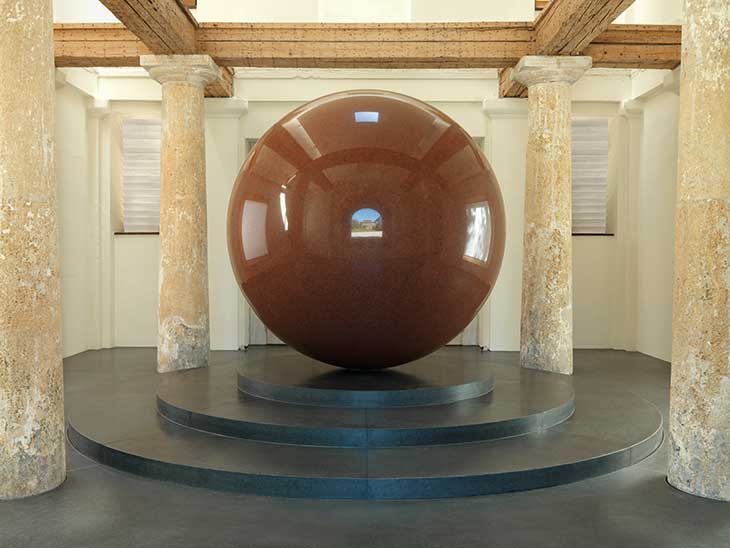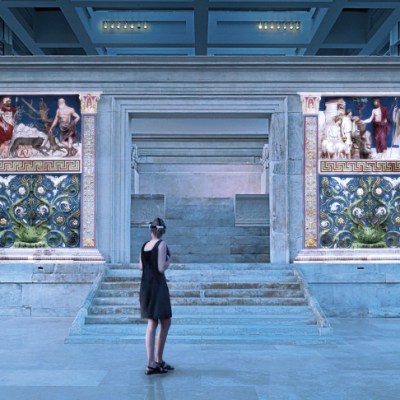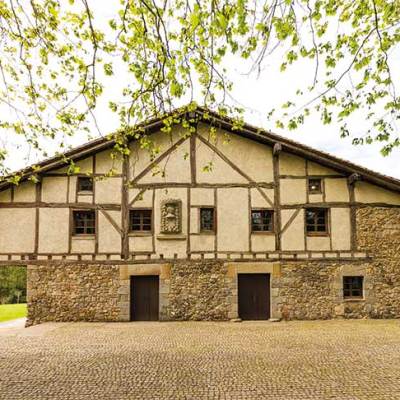Passing through the quick succession of galleries and lawns at the centre of Munich’s museum district, you might arrive at a plain pavilion with a narrow, wooden door. This is the Türkentor (‘Turks’ Gate’), the gatehouse and only surviving fragment of Prince Arnulf of Bavaria’s barracks, which contains a single exhibit: Walter De Maria’s Large Red Sphere (2010). I am enticed by the door one afternoon in May as I leave the Pinakothek der Moderne, having lost several hours to Kirchner’s angst and the dark insinuations of Anselm Kiefer. Once I’m inside, the building feels all the more detached from its military past, with De Maria’s colossal granite mass commanding reverential silence from the sparse few who have also ventured in. Our principal reminder of the outside world is the Alte Pinakothek reflected at eye-level in the sphere’s polished surface. Home to Munich’s prized collection of Renaissance and early modern masterpieces, the museum was built in the reign of Ludwig I, between 1826 and 1836, so that paintings acquired over centuries by Bavarian rulers would be accessible to the public. It is one of many grand neoclassical buildings in Munich and, appearing in the Türkentor as a ghostly shimmer, it foregrounds the region’s long-standing liberal embrace of the arts.
Munich’s close historical ties with art have never been contested, but the city has long been in Berlin’s shadow when it comes to contemporary art. Assumptions about Munich’s cultural conservatism frustrate everyone I speak to, but they are being slowly overturned. A particularly compelling example is the Pinakothek der Moderne’s intervention at Herrenchiemsee Palace, which lies outside the city on the island of Herreninsel on Chiemsee lake. It was begun in 1878 by Ludwig II but left unfinished after his mysterious death. Known as the Bavarian Versailles, which slightly overstates its splendour, there is no doubt that the state apartments are astonishingly ornate when compared to the bare brick walls of the cavernous, incomplete north wing. This was left almost entirely unused until 2013, but now displays mid to late 20th-century art, much of it minimalist, in a temporary exhibition series called Königsklasse.
Installation view of Large Red Sphere (2010) by Walter De Maria in the Türkentor, Munich. Photo: Haydar Koyupinar/Bayerische Statsgemäldesammlungen; © Estate of Walter De Maria

Suspecting that the visitor’s senses will have been lulled by the palace’s excessive grandeur, Corinna Thierolf, chief curator of the Pinakothek der Moderne, hopes to wake them by creating a viewing experience typical of minimalist art, through which we are forced to stand back or move in closer. The formal contradictions of the works, which range considerably in shape and size, are heightened by dramatic shifts in mood. I am most impressed by the nimble billows of salvaged steel from John Chamberlain and the jagged black voids of Arnulf Rainer, on which we perceive faint handprints, traces of the artist’s movements that hint at a presence in the dark. Immense, gestural paintings by Kazuo Shiraga are having their first museum outing in Germany, and by contrast the abstract compositions of Etel Adnan are small-scale windows looking quietly out across ‘soul landscapes’.
For Thierolf the space provides a chance to move beyond the static format of the museum. ‘The collection is in progress, so it has to move. We add new instalments all the time,’ she explains. Rather than categorising the works in exhibitions, Thierolf has arranged them as ‘editions’ in an ongoing rotation. It is an effective strategy by which her presentation of loaned works has in many cases convinced private donors to buy them on the museum’s behalf. To the Pinakothek der Moderne’s collection, she has added several monuments by Dan Flavin, including untitled (to you, Heiner, with admiration and affection) (1973), a 16-metre-long barrier dedicated to the dealer Heiner Friedrich, who opened his first gallery in Munich in 1963. Cage-like and radiating a synthetic, lime-green glow, it is staged in antithesis to the sprawling lawns outside.
Installation view of Without Beginning and Without End (2005–18) by Wolfgang Laib and Cross, Black, on Light Brown (1969) by Arnulf Rainer, in the north wing of the Herrenchiemsee Palace on the island of Herreninsel. Photo: Nicole Wilhelms; © Bayerische Staatsgemäldesammlungen; © Wolfgang Laib; © Arnulf Rainer.

Another acquisition made with the help of a private donor is Wolfgang Laib’s Without Beginning and Without End (2005–18), which consists of two towering monuments made of beeswax and modelled on the ziggurats of ancient Mesopotamia. Emanating a strong and subtly sweet smell, their smoothly indented edges find an echo in the more crudely serrated corners of the brick walls. Laib tells me, ‘When you look back at art which lasted and which was important for the future then it has to transcend the today.’ The hope he expresses of evading the zeitgeist in favour of the eternal (zeitlos) may be at odds with more ephemeral artistic developments occurring elsewhere in the outskirts of Munich.
In recent years the city council has set up ‘Creative Business’, a panel of specialists that allocate funding and consultation for artists and cultural start-ups. I meet Loomit, a local street artist, at the Container Collective, a ‘pop-up city’ in the up-and-coming Werksviertel district, once the site of a Pfanni potato factory but more recently known for its nightclubs. Loomit, a member of underground art movements since the 1980s, tells me that the local government has actively embraced his work, regularly commissioning public murals as a way to discourage casual graffiti. Munich is a prosperous and rapidly expanding city, but one approved way for artists to get around the rising rent of housing redevelopments is by filling buildings scheduled for demolition.
Loomit takes me around Z Common Ground in Laim, a 4,000-square-metre commercial building where he and two other curators have invited 100 local artists to set up temporary, makeshift studios. The installations are remarkably clever and immersive for something so short-lived; they will have gone even before this article appears in print. The artists, I’m assured, accept the fleeting nature of these spaces, not least because a sense of urgency attracts more typically apathetic audiences.
Munich is reasserting itself and has developed a pleasantly offbeat art scene. Not everything is built to last, but the city has an eye for lurking opportunities. Herrenchiemsee was long considered incomplete after Ludwig II’s sudden death, but Thierolf sees things differently. ‘It’s so important that this isn’t only a place of history,’ she says. ‘He left us some empty space!’
From the July/August 2019 issue of Apollo. Preview and subscribe here.


